AMERICAN FOOTBALL MONTHLY THE #1 RESOURCE FOR FOOTBALL COACHES
Article CategoriesAFM Magazine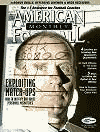
|
Its All About Optionsby: Nathan M. CochranRunning Backs Coach, UW-Platteville © More from this issue 3 Ways to Utilize the Option in the Shotgun and the Spread Offense The option remains one of the most successful concepts in football. It forces the defense to play assignment football and account for each ball carrier. On offense it allows you to leave defenders unblocked at the point of attack. Option concepts have evolved over the last 40 years. Most offensive coordinators have incorporated some form of option into their offenses. In this article I will discuss three different ways the option can be used in the shotgun and spread offenses. The first is a simple double option, often called the speed option. Most offenses use this because it is good against defenses which blitz a lot and it’s not a complicated read for the quarterback to master. Here at UW-Platteville we use the “Speed Option.” We employ a load and a “Base” scheme (See Diagrams 1 and 2).  Diagram 1 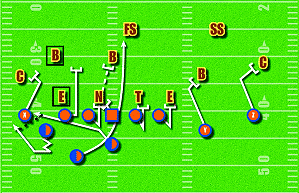
Diagram 2 In the “Load” scheme, the end man on the line of scrimmage (LOS) is to be blocked. He would normally be your “pitch man” (the defender the quarterback determines whether to keep or pitch the ball off of) in the Speed Option. In the “Base” scheme we are optioning the end man on the LOS. The quarterback receives the snap and runs toward the play-side tackle’s outside hip. He attacks the inside shoulder of defender being read. The quarterback reads his shoulders. If he can read the defender’s numbers and the defender is attacking, he should pitch. If the defender’s shoulders are square to the LOS and he is “feathering” (trying to defend both the quarterback and running back) the quarterback should turn up underneath the read man and get what yardage he can. The running back will take a depth-step and an open-step to move to the proper pitch relationship of four yards deep and one yard behind. The second option is a “Triple Option.” There are two types of “Triple Option” which can be run from the shotgun spread. At UW-Platteville we only run one version but I will expound on both. Urban Meyer (Head Coach at University of Florida) and Tony DeMeo (Head Coach at University of Charleston) have made both versions popular by running each successfully. The first “Triple Option” is a speed Option/Shovel pass hybrid. It can be run out of a single-back set with a slot receiver running the underneath shovel or with a two back set (See Diagrams 3 and 4). 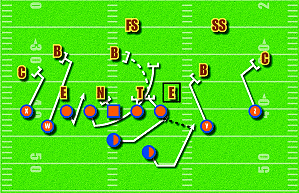
Diagram 3 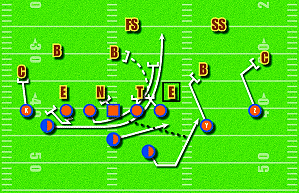
Diagram 4 The quarterback still reads the end man on the LOS. If the defender comes up field hard, the quarterback will shovel pass the ball underneath. If the defender stays on the LOS with his shoulders square or he squeezes with the tackle’s down block, the quarterback carries out the speed option, attacking the line of scrimmage. The backside slot or running back will run the shovel route and read the block of the pulling guard. The playside running back or slot will run the same pitch relationship described in the “Speed Option.” An additional advantage to the “Triple Option” is the shovel pass. If the receiver drops it, it is an incomplete pass and not a fumble. The second version of the “Triple Option” uses the mesh-concept. This “Triple Option” was developed from the “Inside Zone/Zone Keep” play that a lot of teams run out of the shotgun spread. This version is designed to take advantage of the defense end and takes advantage of defenses that do not play assignment football (See Diagram 5). The running back and the offensive line run “Zone Right” reading the backside defensive end. If the DE crashes down the LOS (chasing the running back) the quarterback keeps the ball. If the end stays home the quarterback gives the ball. If the DE crashes, the quarterback pulls the ball and goes to the next phase of the option. Now the quarterback is running “Speed Option” with the backside running back or a slot wide receiver who has to come in motion or has begun from a shortened split (See Diagrams 6 and 7). The pitch key is now the apex linebacker or the next defender outside the defensive end. 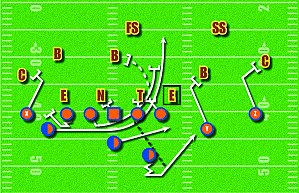
Diagram 5 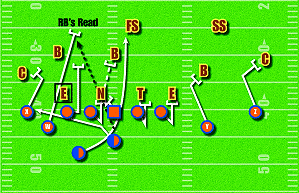
Diagram 6 
Diagram 7 The addition of any of these three plays can add new wrinkles to a shotgun spread offense. The ones used by the UW-Platteville coaching staff provide a great addition to our offense. Though the option is a great play in any offense, it requires a lot of repetition for the quarterback to learn the reads and acquire the necessary timing with the pitchman. Patience and a high level of commitment will ensure you can run the option successfully. |
|
| HOME |
MAGAZINE |
SUBSCRIBE | ONLINE COLUMNISTS | COACHING VIDEOS |
Copyright 2025, AmericanFootballMonthly.com
All Rights Reserved




